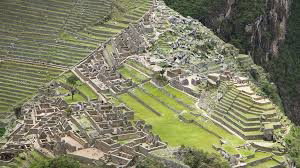The Temple of Artemis at Ephesus, also known as the Artemision , was one of the Seven Wonders of the Ancient World. It was a grand temple dedicated to the Greek goddess Artemis, the goddess of the hunt, fertility, and childbirth. The temple was located in the ancient city of Ephesus , which is now modern-day Turkey . The construction of the temple began in the 6th century BC , during the reign of King Croesus of Lydia. It was designed by the Greek architect Chersiphron and his son Metagenes . The temple was built on a marshy plain near the river Cayster, and it was raised on a platform to prevent flooding. The temple was made of marble and was adorned with sculptures and decorations. The temple was destroyed and rebuilt several times throughout history. The first temple was destroyed by a flood in 550 BC , and it was rebuilt by Croesus . The second temple was destroyed by arson in 356 BC , and it was rebuilt by Alexander the Great. The third te...
Machu Picchu is a breathtaking ancient Incan citadel located in the Andes Mountains of Peru. It is considered one of the most iconic and mysterious archaeological sites in the world, attracting millions of visitors every year. The site was built in the 15th century and was abandoned by the Incas during the Spanish conquest in the 16th century. It was rediscovered in 1911 by Hiram Bingham, an American explorer, and has since become a UNESCO World Heritage Site.
The citadel is situated on a mountain ridge, 2,430 meters above sea level, and is surrounded by steep cliffs and lush green forests. The site is divided into two main areas: the agricultural sector and the urban sector. The agricultural sector consists of terraces, canals, and irrigation systems that were used to grow crops such as maize, potatoes, and quinoa. The urban sector includes temples, palaces, and residential areas that were used by the Incan nobility.
One of the most impressive structures in Machu Picchu is the Temple of the Sun, which is believed to have been a place of worship and astronomical observation. The temple is built with precision and is aligned with the sun during the winter solstice. The Intihuatana Stone, also known as the "hitching post of the sun," is another important structure in the citadel. It is a carved stone pillar that was used to mark the position of the sun during the solstices and equinoxes.
The construction of Machu Picchu is a testament to the advanced engineering and architectural skills of the Incas. The site was built without the use of mortar, and the stones were cut and fitted together so perfectly that not even a blade of grass can fit between them. The Incas also built an extensive network of roads and bridges that connected Machu Picchu to other parts of their empire.
Visiting Machu Picchu is a once-in-a-lifetime experience that should not be missed. The site can be reached by hiking the Inca Trail, which is a four-day trek that takes you through stunning mountain landscapes and ancient Incan ruins. Alternatively, you can take a train from Cusco to Aguas Calientes, a small town located at the base of Machu Picchu. From there, you can take a bus or hike up to the citadel.
When visiting Machu Picchu, it is important to respect the site and its history. Visitors are not allowed to touch or climb on the structures, and littering is strictly prohibited. It is also recommended to visit the site early in the morning or late in the afternoon to avoid the crowds and get the best views of the citadel.
In conclusion, Machu Picchu is a remarkable archaeological site that showcases the ingenuity and sophistication of the Incan civilization. It is a must-visit destination for anyone interested in history, architecture, and natural beauty. The site's remote location and stunning vistas make it a truly unforgettable experience that will stay with you for a lifetime.






Comments
Post a Comment